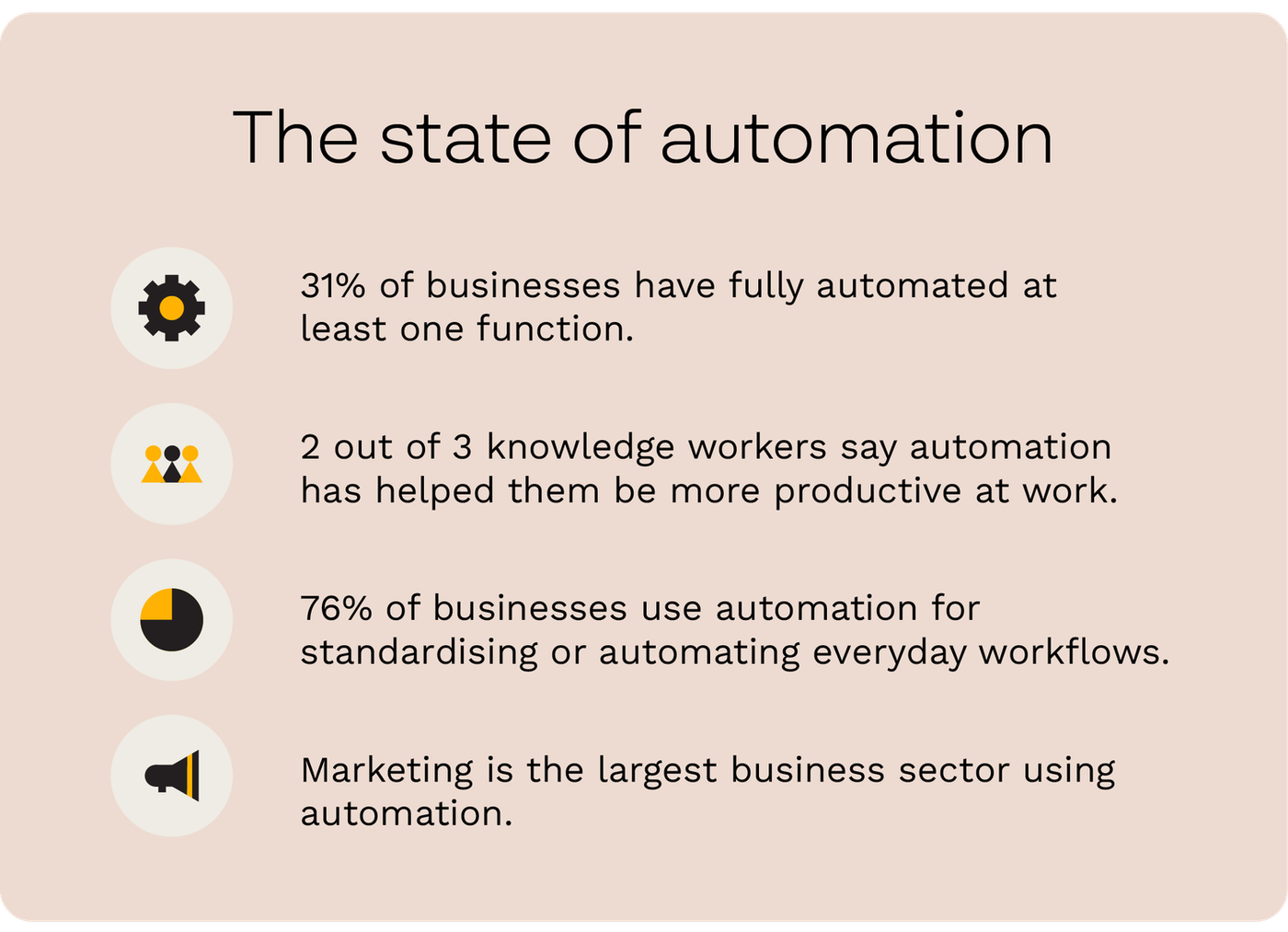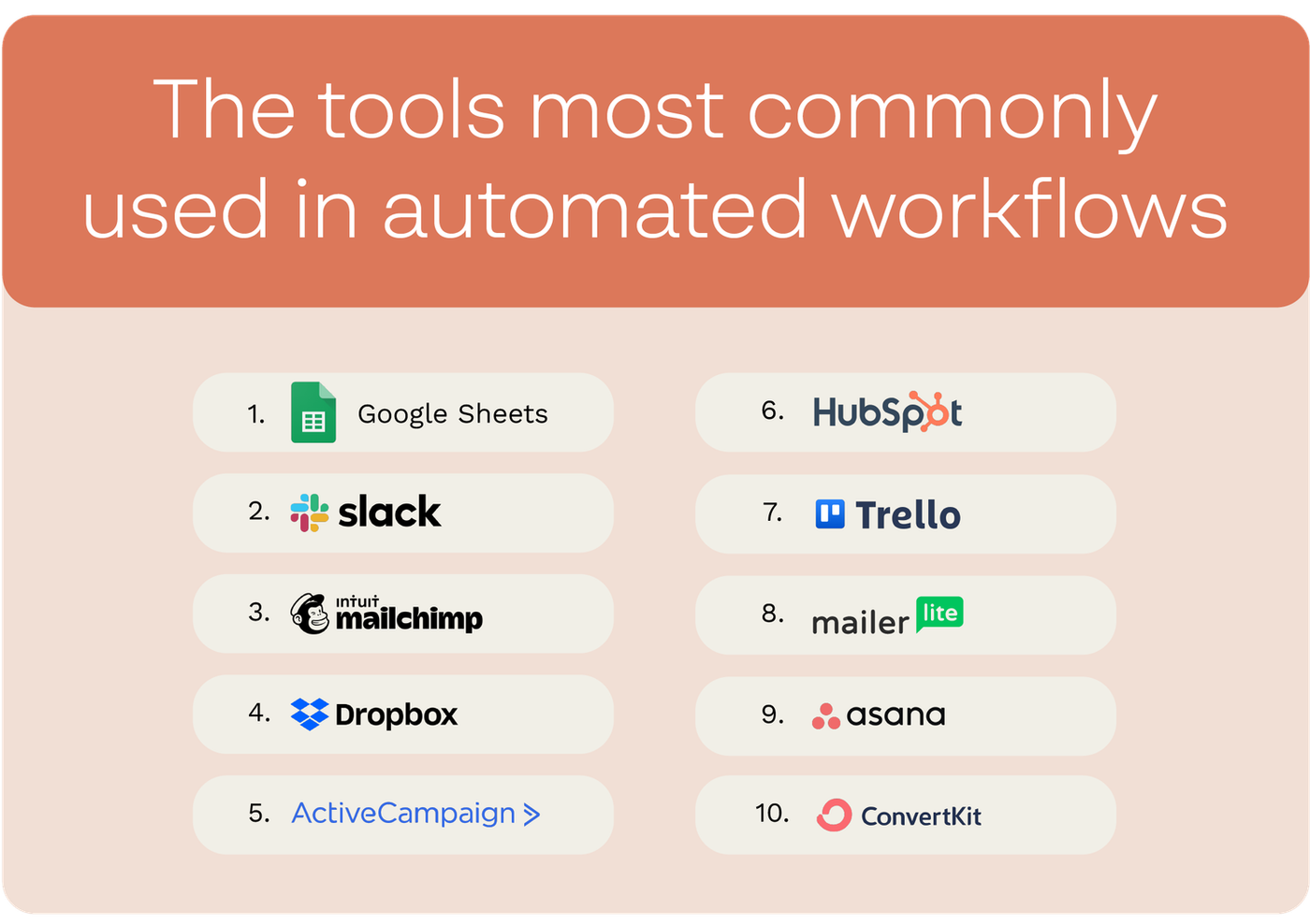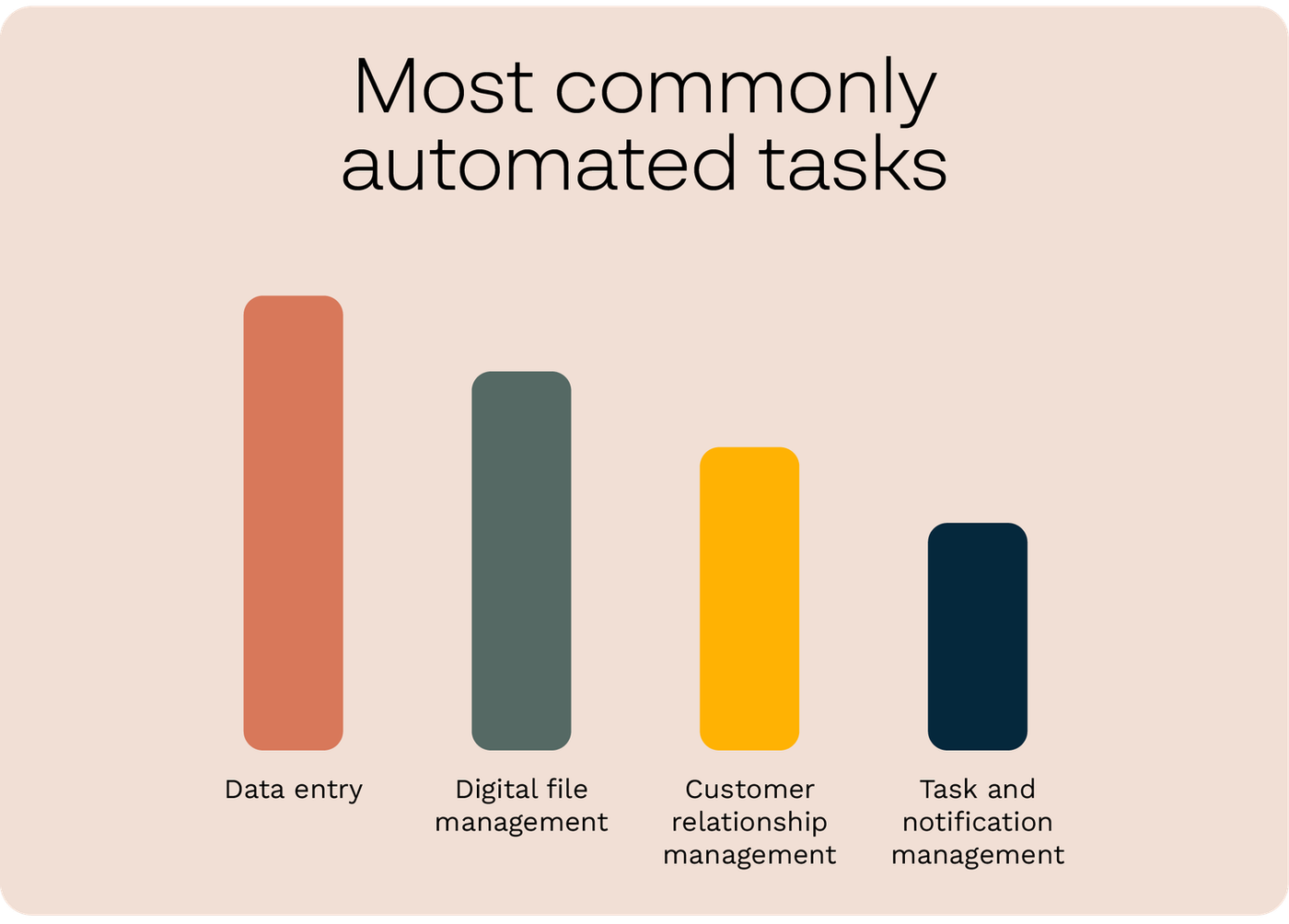
All Solutions

Explore all the solutions you can create with Paperform: surveys, quizzes, tests, payment forms, scheduling forms, and a whole lot more.
See all solutions











Connect with over 2,000 popular apps and software to improve productivity and automate workflows
See all integrationsProducts
Solutions
All Solutions

Explore all the solutions you can create with Paperform: surveys, quizzes, tests, payment forms, scheduling forms, and a whole lot more.
See all solutionsIntegrations

Connect with over 2,000 popular apps and software to improve productivity and automate workflows
See all integrationsResources
73 automation statistics for 2024

The topic of AI and automation is more important than ever. While automation streamlines processes, increases efficiency and reduces the need for traditional labour, it creates anxieties about what the future of work—and life looks like for humans.
With more companies than ever adopting automation, we thought it important to understand the state of automation, and how it's expected to evolve in the coming years. To do so, we've curated a list of automation statistics that give insights into the adoption and impact across various sectors.
From the growth of automation in marketing to the increase use of AI-powered chatbots in customer service, these statistics paint a clear picture: automation is here to stay, and it's likely to play an even greater role in 2024 and beyond.
So whether you're a business owner looking to stay ahead of the curve or just want to learn more about the impact of automation, this post is for you. Use the table of contents to go to a certain category, or read on for all the top automation statistics.
Top automation statistics
Wondering just how important automation is in the modern workplace? Here are some of the most interesting automation statistics we think you should know:

- 50% of work can be automated in today’s age (McKinsey).
- 31% of businesses have fully automated at least one function (McKinsey).
- The number of automated jobs increases by 14% every year (International Federation of Robotics).
- 94% of workers say they perform repetitive, time-consuming tasks in their role (Zapier).
- 90% of knowledge workers say that automation has improved people’s lives in the workplace (Zapier).
- 76% of businesses use automation for standardising or automating daily workflows; 58% use automation for data/reporting for planning, and 36% use it for regulation or compliance (Formstack).
- 88% of small business owners say automation allows their company to compete with larger companies (Zapier).
- 2 out of 3 knowledge workers say automation has helped them be more productive at work (Zapier).
- $46,000—the average saving for organisations using workflow automation tools (Formstack).
- The most commonly automated tasks include: adding data to Google Sheets, sending Slack messages, uploading files to Dropbox, adding subscribers to a Mailchimp list, and creating a contact in ActiveCampaign (Paperform).
- Paperform users automated over 10 million actions through direct integrations in 2022. (Paperform).
- 65% of knowledge workers are less stressed at work because they automate manual tasks (Zapier).
- The five software most commonly used in automated workflows: Google Workspace, Slack, Mailchimp, Dropbox, and ActiveCampaign (Paperform).
The impact of automation statistics
On the one hand, automation can increase efficiency and reduce the need for human labour, leading to cost savings and higher profits for businesses.
It also frees up human workers to focus on more complex and creative tasks, allowing them to employ their unique skills and abilities in a more meaningful way.
However, automation can also lead to job displacement and wage stagnation, as machines can perform certain tasks at a faster and cheaper rate than humans.
Impact on Employment
- One in four jobs in the United States will face a high risk of automation job displacement by 2030 (Brookings).
- 70% of routine physical and cognitive tasks are jobs at risk of automation in the United States (Brookings).
- 24% of US jobs requiring a bachelor’s degree, and 55% of those with lower requirements, have some kind of job automation potential (Brookings).
- 1.5 million or 7.4% of jobs in England are currently at risk of becoming obsolete due to automation (Office for National Statistics).
- Younger people are more likely to be in roles affected by job automation.
- 15.7% of working 20 to 24 year olds are in jobs at high risk of automation (Office for National Statistics).
- 37% of people are worried about automation replacing their jobs (PwC).
- 56% of people believe that governments should do whatever it takes to protect jobs from automation (PwC).
- The top challenges in adopting workflow automation tools include: ease of use, choosing the best tool, cost, buy-in of leadership, compliance, and data security (Formstack).
Benefits of automation
- Nearly 70% of workers believe automation will bring opportunities to qualify for higher skilled work (International Federation of Robotics).
- 57% of employers want to use automation in order to improve human performance and productivity (Willis Towers Watson).
- 24% of employers would employ the automation of jobs in order to reduce operating costs (Willis Towers Watson).
- 34% of SMBs say automation allows them to spend less time on administrative tasks, and 28% say it reduces the amount of time it takes to follow up with a lead (Zapier).
- 35% of SMBs say using automation allows them to provide better customer service and support (Zapier).
- 34% of SMBs say automating tasks like data entry reduces errors (Zapier).
Business process automation statistics
Businesses are looking to automate repetitive processes like data entry, document creation, and lead management.
While business process automation is yet to reach mass adoption, the results are overwhelmingly positive from those who already use it:
 Source: Paperform
Source: Paperform- When it comes to business processes, 60% of occupations could save 30% of their time with automation (McKinsey).
- The global Business Process Automation (BPA) market size is expected to grow from USD 9.8 billion in 2020 to USD 19.6 billion by 2026 (GlobeNewsWire).
- Just 2% of respondents have all their business processes modelled, suggesting that few organisations are ready for automation at scale (Mordor Intelligence).
- Two-thirds of respondents say their organisations are at least piloting the automation of business processes (McKinsey).
- Business process automation is one of the most commonly deployed technologies with 57% of respondents stating it is beyond the piloting stage (McKinsey).
- The most commonly automated tasks include: data entry (38%), document creation and organisation (32%), lead management (30%), and inventory management (27%) (Zapier).
- The top five industries in terms of integration use are: startups, agencies, marketing, education, and customer service (Paperform).
 (Source: Paperform)
(Source: Paperform) Marketing automation statistics
These statistics show the clear benefits that marketing automation can provide for businesses regarding lead generation, conversion rates, and decision-making.
- 43% of respondents said that improving customer experience was the most important advantage gained from marketing automation (Statista).
- 35% said marketing automation improved data and decision-making (Statista).
- 38% of marketers believe automation will help staff make better use of their time (Statista).
- Lead quantity rises by 80% for those using marketing automation (Oracle)
- Over 75% of marketers have increased conversions since implementing marketing automation (Oracle).
- In 2020, the market amounted to 3.6 billion U.S. dollars and is expected to reach a triple of that value by the end of 2027 (Statista).
- It’s been projected that the marketing automation software industry would grow at a CAGR of 17.67 percent between 2021 and 2027 (Statista).
- 84% of surveyed marketers have successfully used marketing automation to achieve their top priorities (Ascend2).
- Marketing is the largest business sector using automation (HubSpot).

Social media marketing automation
- 47% of respondents stated they use automation in social media marketing (Statista).
- 39% of B2B companies plan on implementing marketing automation to aid with their social media management efforts in the year ahead (Act-On).
- Social media management is the second largest area where marketing automation is used (Ascend2 and Research Partners).
- Companies can save more than 6 hours a week by automating their social media content and ads (Entrepreneur).
Email marketing automation
- Email marketing is the most often automated channel, named by 65% of marketers (Statista).
- Expanding email automation is a priority for 59% of marketers (Litmus).
- The top three most used email marketing automation techniques are initial welcome sequences or autoresponders (69%), nurture emails based on content browsed or downloaded (46%), and up-sell or cross-sell emails to existing customers (SpotlerUK).
- Companies that use automated marketing software to send out emails receive twice the number of leads and 58% more conversions than those that send out email blasts (Moz).
- 50% of SMBs use marketing automation software to send automated email drip campaigns (Statista).
Content marketing automation
- The number of marketers using automation for content management has grown from 22% in 2021 to 29% in 2022 (Ascend2 and Research Partners).
- “Content marketing automation” is the 12th most expensive keyword in the content marketing industry (Semrush).
- 48% of marketers automate content (HubSpot).
Sales automation statistics
- More than 30% of sales-related activities can be automated (McKinsey).
- Only one in four companies has automated at least one sales process (McKinsey).
- Benefits of automation in sales include an overall cost reduction of 10 to 15% and a reduction of order processing time (McKinsey).
- AI adoption in sales has been forecasted to grow 139% between 2020 and 2023 (Salesforce).
- Predictive intelligence adoption in sales is forecasted to grow 118% between 2020 and 2023 (Salesforce).
- Automation is proven to boost sales productivity by 14.5% (Nucleus Research).
Human resources automation statistics
Human resources (HR) automation can include everything from payroll and benefits management to employee onboarding and performance evaluations.
- Only 37% of HR job functions are commonly automated (Forbes).
- 56% of companies using AI for HR are trying to automate repetitive tasks (Gartner).
- 54% of HR professionals do not see automation as a threat to their job, but instead as a means to focus their valuable time on better tasks (Northeastern University).
- HR managers lose 14 hours per week on tasks that could be automated (CareerBuilder).
- An estimated 56% of tasks performed by HR can be automated without drastic changes to processes (McKinsey).
- About 73% of HR’s time is taken up by monotonous administrative tasks (Frevvo).
- 25% of companies report using HR automation, mainly for recruitment and hiring (SHRM).
- 69% of HR professionals that do use automation in hiring reported that it significantly decreased the time spent on this process (SHRM).
- Companies that do use HR automation said their onboarding process was 67% faster (Nucleus Research).
- 30% of survey respondents agreed that HR automation does help them reduce any potential bias from their hiring process (SHRM).
Customer service automation statistics
With customer service automation, businesses can more effectively address customer inquiries and provide a more seamless customer experience, while freeing up valuable resources for more complex and valuable tasks.
This can include everything from automating responses to frequently asked questions to using artificial intelligence (AI) to handle customer inquiries.
- 40% of U.S. consumers use chatbots to engage with retailers (Siteefy).
- 74% of U.S. customers expect a website to have a chatbot available for assistance (Siteefy).
- 60% of customer service teams automate their “next best action” and collect 65% of customer feedback automatically (Siteefy).
- In 2019, 25% of all customer interactions were automated through AI and machine learning. This number is expected to grow to 40% by 2023 (Gartner).
- By 2030, it’s estimated that a billion service tickets will be raised automatically by customer-owned bots (Gartner).
- The chatbot market size will be over $1.34 billion by 2024 (Global Market Insights).
- 68% of customer service agents report feeling overwhelmed with the amount of work they have to do manually (Zendesk).
Discover how Papersign, our new eSignature solution, revolutionizes document workflows with seamless, efficient automation. Get started free.
Ecommerce automation statistics
Ecommerce automation refers to using technology to automate various tasks and processes related to operating an online store.
These include a variety of order and inventory management processes, from managing stock levels to creating shipping labels and sharing tracking information with third-party fulfilment centres.
- 95% of customer-retailer interactions will take place on automated systems (such as chatbots) by 2025 (Siteefy).
- Automated warehouses are becoming commonplace, with an expected growth of 13,6% by 2025, reaching nearly $31 billion in market value (Siteefy).
- Automated warehouses are 40% more likely to ship orders within one day of the order being made (Robotics Business Review).
Automation is the future
As we look to the future, it's clear that automation will continue to play a central role in many aspects of our lives. Whether we are interacting with AI chatbots or using AI-powered tools to make decisions, automation is likely to shape the way we work and do business in the coming years.
For business owners, this will require adapting to new technologies and ways of working, but the benefits are well worth the effort. Automation is best thought of as an augmentation to human labour and creativity, rather than a replacement.
Ultimately, the key to successfully navigating the future of automation is to approach it with a mindset of collaboration and innovation, rather than fear and resistance. By embracing the opportunities that automation brings and working together to address any challenges that may arise, we can create a future that is more efficient, productive, and rewarding for all.
Considering getting started with automation? Here are some more resources:
Form a better life now.
Get your 7 day unrestricted trialHere is the ultimate list of online form builders, what they do best, their pricing, and examples to...
Independent retailers are some of the smartest operators in small business—but they’re forced to wor...
Independent retailers are some of the smartest operators in small business—but they’re forced to wor...
Looking for a worthy alternative to Zapier? In this guide, we've reviewed the best automation platfo...